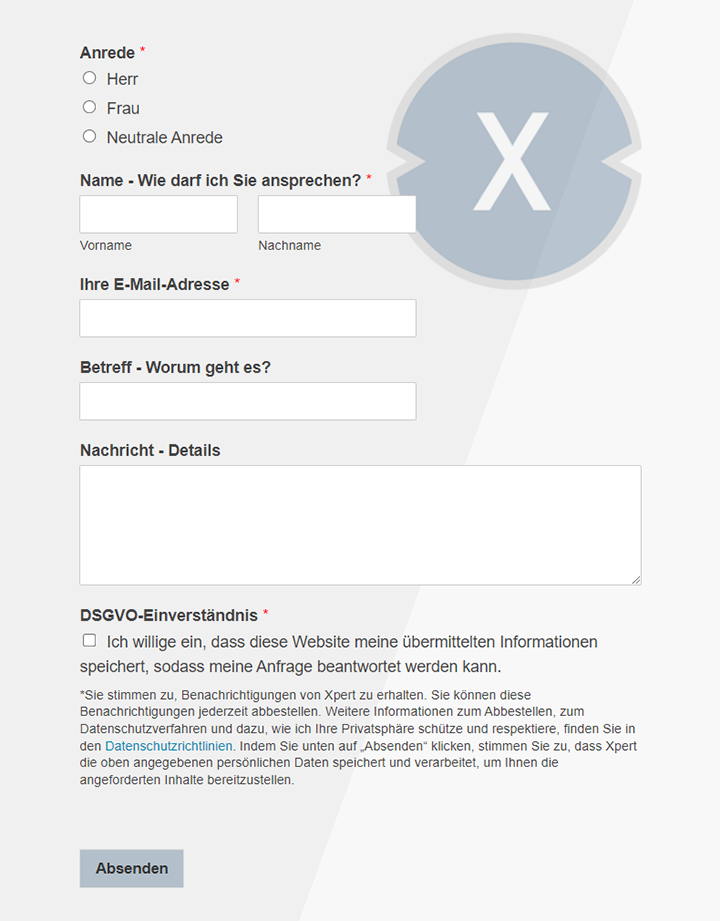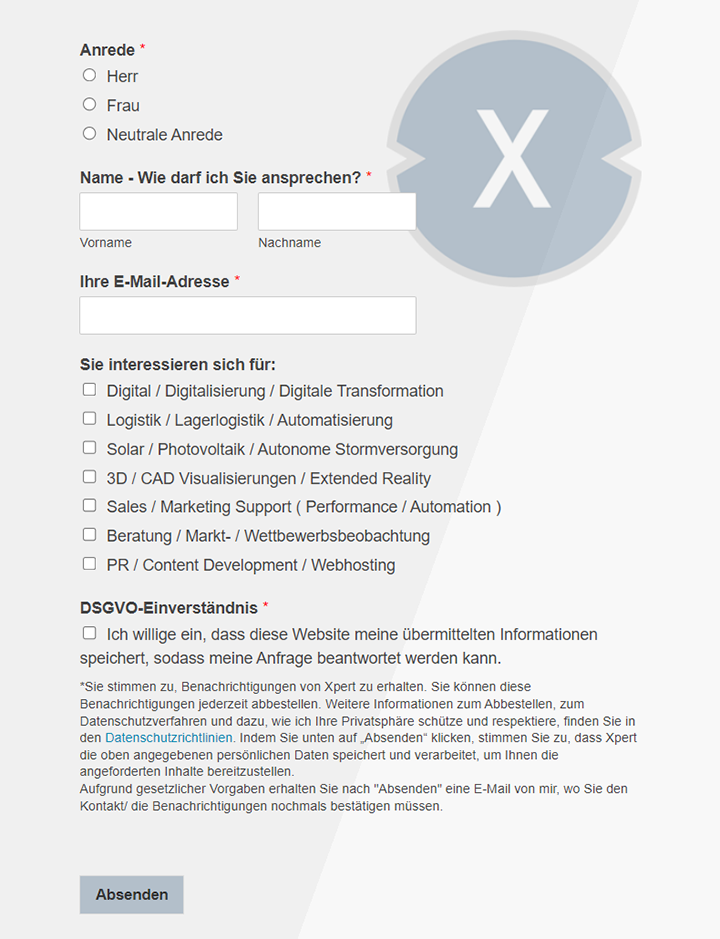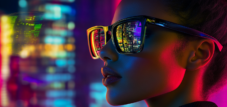The Meta Connect conference presented the next generation of intelligent eyewear technology: The Meta Ray-Ban Display
Xpert pre-release
Language selection 📢
Published on: September 18, 2025 / Updated on: September 18, 2025 – Author: Konrad Wolfenstein

The Meta Connect conference presented the next generation of intelligent eyewear technology: The Meta Ray-Ban Display – Creative image: Xpert.Digital
Revolution with glitches: Meta's smart glasses impress – but the live demo failed
Never look at your phone again: This is how the new display glasses from Meta and Ray-Ban work
The world of augmented reality has reached a significant turning point with Meta's latest innovations. Mark Zuckerberg unveiled revolutionary eyewear technology at the Meta Connect conference that has the potential to fundamentally change how we interact with digital information. These developments mark a decisive step toward a future where computers are seamlessly integrated into our everyday lives.
The Meta Connect conference took place on September 17 and 18, 2025, and was hosted by Meta as a central event for the latest developments in virtual reality, artificial intelligence, and XR technologies. The 2025 conference was held entirely digitally and broadcast worldwide as an online event.
Suitable for:
The Meta Ray-Ban Display: First step into a new era
The first commercial product from Meta's new generation of smart glasses is called the Meta Ray-Ban Display and, for the first time, combines an integrated display with elegant eyewear aesthetics. These glasses are fundamentally different from previous smart glasses, as they feature a small but high-resolution screen integrated directly into the right lens.
The display offers a resolution of 600 x 600 pixels and allows for the presentation of a wide variety of information directly in the user's field of vision. Text messages from WhatsApp, captured photos and videos, navigation assistance, and responses from the integrated AI assistant can be displayed without the user having to pick up their smartphone. A particularly innovative feature is the ability to transcribe conversations in real time and display them as subtitles, which is extremely useful both in noisy environments and for people with hearing impairments.
The glasses are equipped with a 12-megapixel camera and feature integrated speakers in the temples. The battery life is up to six hours with mixed use, and the included charging case can extend the total usage time to up to 30 hours. The design is deliberately inspired by classic Ray-Ban models, yet at 69 grams, the glasses are only slightly heavier than conventional glasses.
The Meta Neural Band: Control via muscle impulse instead of touch
The real innovation of the Meta Ray-Ban Display, however, lies in its control system. The so-called Meta Neural Band is a waterproof wristband that uses electromyography to capture the smallest muscle movements in the wrist and translates them into control commands for the glasses. This EMG technology allows users to operate the glasses with subtle finger movements, without having to touch them directly or use a separate input device.
The Neural Band can recognize a wide variety of gestures: pressing your thumb and index finger together to select, swiping for navigation, or writing letters by tracing them with your finger on a surface. During the presentation, Zuckerberg demonstrated how he wrote letters on a surface, which were then automatically converted into a text message. The technology is based on years of research by Meta and Carnegie Mellon University, collecting data from over 10,000 test subjects to develop a system that works for new users without individual calibration.
The Neural Band's battery lasts up to 18 hours, and all signal processing occurs locally on the device, minimizing privacy concerns. This non-invasive alternative to implanted brain chips offers a safe and practical solution for controlling digital devices.
The Meta Orion Project: A Look into the Future
While the Ray-Ban Display is already commercially available, Meta offered a fascinating glimpse into the future of augmented reality with the Orion prototype. These true AR glasses, which Meta has been working on for a decade, represent the world's most advanced AR display and weigh less than 100 grams.
At the heart of Orion's technology are micro-LED projectors that, combined with revolutionary silicon carbide lenses, project holographic 3D images directly into the user's field of vision. Silicon carbide was chosen because it has a refractive index 50 percent higher than glass, while also being lighter and more durable. This material property enables an exceptionally wide field of view of 70 degrees, significantly exceeding what other AR glasses can currently offer.
The lenses are made of synthetic silicon carbide, a material also used in space telescopes and military radar systems. The complex manufacturing and processing of this material makes the display the most expensive component of the glasses, accounting for approximately 90 percent of the estimated manufacturing costs of $10,000 per device.
Suitable for:
- Project Nazare | Smart Glasses Orion from Meta: The future of augmented reality – extended reality with Metaverse is only a matter of time
Revolutionary control concepts
The Orion glasses utilize a combination of different input methods: speech recognition, eye and hand tracking, and the aforementioned EMG wristband. This multimodal control enables natural and intuitive operation, allowing users to select objects using simple gestures such as pinching their thumb and index finger together or navigate using swiping gestures.
Particularly impressive is the integration of Meta AI, which acts as a central assistant and interprets both hand gestures and voice commands. The AI can recognize objects in the real environment, suggest recipes based on available food, perform real-time translations, and answer complex questions.
Technical innovation in detail
The Orion glasses feature seven integrated cameras and sensors, as well as a series of specialized chips developed by Meta specifically for these AR glasses. The sophisticated system uses waveguide technology to precisely direct light from the uLED projectors into the eyes. These projectors are located in the temples and shine light into the lenses, which are equipped with nanostructured 3D elements.
The frame is made of magnesium, a super-lightweight metal known for its strength and ability to dissipate heat. This material property is crucial, as the compact electronics generate considerable heat. To keep the glasses as light as possible, part of the computing power is outsourced to an external pocket computer called the Compute Puck. This cellphone-sized device communicates wirelessly with the glasses and performs complex calculations.
Applications and practical benefits
The possible uses of both types of glasses are diverse and future-oriented. With the Ray-Ban Display, users can seamlessly switch between the physical and digital world without having to look away from their surroundings. Navigation aids are displayed directly in the field of vision, incoming messages can be discreetly read and responded to, and the integrated AI can analyze and explain visual information in real time.
The Orion glasses go a step further, enabling the display of life-size holograms of people, working with multiple virtual screens in a room, and immersive entertainment experiences such as cinema-sized virtual displays. During video calls, the other person can appear as a holographic avatar in your room, allowing gestures and facial expressions to be transmitted naturally.
🎯🎯🎯 Benefit from Xpert.Digital's extensive, fivefold expertise in a comprehensive service package | R&D, XR, PR & SEM

AI & XR 3D Rendering Machine: Fivefold expertise from Xpert.Digital in a comprehensive service package, R&D XR, PR & SEM - Image: Xpert.Digital
Xpert.Digital has in-depth knowledge of various industries. This allows us to develop tailor-made strategies that are tailored precisely to the requirements and challenges of your specific market segment. By continually analyzing market trends and following industry developments, we can act with foresight and offer innovative solutions. Through the combination of experience and knowledge, we generate added value and give our customers a decisive competitive advantage.
More about it here:
Meta-glasses: Will Ray-Ban and Orion replace the smartphone?
Market launch and availability
The Meta Ray-Ban Display is already available in the US for $799 and is offered in black and sand. The package includes both the glasses and the Neural Band. Information on availability in Germany and other European markets is pending.
The Orion glasses, on the other hand, are currently only available as a prototype and are used exclusively by Meta employees and select testers. Meta plans to use the insights gained from this prototype to develop a significantly more affordable consumer version. The second generation, called Artemis, is scheduled to launch in 2027, but will feature less advanced technology to reduce costs.
Suitable for:
- Smart glasses with hidden camera and AI foreign language translation: The Ray-Ban Meta Wayfarer RW4008
Challenges and technical hurdles
However, technical difficulties arose during the live demonstration, demonstrating that the technology is not yet fully developed. Zuckerberg was unable to accept a video call, and a chef participating live had problems with the AI's voice control. These glitches were attributed to poor Wi-Fi connections and highlight the challenges that remain in seamlessly integrating such systems into everyday life.
The manufacturing costs of the advanced technologies are also a significant factor. The silicon carbide lenses of the Orion glasses are manufactured in the USA because export restrictions make international manufacturing difficult. These geopolitical and technological hurdles lead to high production costs and initially limit availability.
The role of artificial intelligence
Meta AI plays a central role in both eyewear systems, acting as an intelligent assistant that understands the context of its surroundings. The AI can identify objects, translate text, answer questions, and even perform creative tasks. Particularly noteworthy is its ability for contextual recall, which allows for natural, multi-step conversations without having to restart the context.
The integration of Meta AI with the Llama 4 model brings significant improvements in image understanding and document analysis. The AI can now not only see what the user sees, but also interpret complex visual information and provide relevant support. This development transforms the glasses into more than just display devices—they become intelligent companions in everyday life.
Impact on society and everyday life
The introduction of glasses with integrated displays and AI assistants could have far-reaching societal implications. Meta sees this technology as the next step after the smartphone and a way to achieve personal superintelligence. The vision is to help people remain more present and attentive in their physical environment while maintaining access to digital information and services.
For people with disabilities, EMG technology opens up entirely new possibilities for computer interaction. Because the system captures nerve signals before any actual movement occurs, even people with limited mobility can use the technology. This could lead to a significant improvement in digital participation.
Competition and market development
The market for smart glasses is developing rapidly, and various technology companies are investing heavily in this future technology. In addition to Meta, Apple, Google, Samsung, and even Amazon are working on their own AR glasses projects. Alibaba has already introduced the Quark AI glasses with the Qwen AI assistant, which focuses particularly on business applications.
Apple reportedly plans to launch its own version of smart glasses in 2026, compatible with the VisionOS ecosystem. Samsung is developing glasses codenamed Moohan, designed as an Android version of the Apple Vision Pro. This development points to intense competition that could accelerate innovation and lower prices.
Market forecasts and growth potential
Market research firms predict significant growth in the smart glasses sector. The global market for smart glasses is expected to grow from fewer than 3 million units sold in 2024 to significantly higher numbers in the coming years. Annual growth rates vary between 14.5 and 29.4 percent, depending on the source and market segment.
Meta itself is already recording impressive sales figures: Sales of Ray-Ban Meta Smart Glasses tripled last year, and a total of over 2 million units have been sold since its launch in October 2023. Monthly active users have quadrupled compared to the previous year, indicating strong adoption of the technology.
Technological breakthroughs and innovations
The glasses presented by Meta represent several significant technological breakthroughs. The development of functional EMG control for consumer products, the integration of high-resolution displays into eyeglass-like form factors, and the use of silicon carbide for optical applications are all remarkable engineering achievements.
The miniaturization of the required electronics, the development of efficient cooling systems, and the creation of seamless wireless communication between the glasses and external computing units demonstrate the high level of technical sophistication that went into these projects. These innovations will likely find application in other areas of electronics and wearable computing.
Data protection and security aspects
Data protection and security play a central role in the development of smart glasses. Meta emphasizes that the processing of the EMG signals takes place entirely on the device, and no biometric data is transmitted to external servers. The glasses feature LED indicators that are activated when photos or videos are taken, ensuring transparency with other people.
However, the integration of AI assistants raises new privacy questions, particularly regarding the continuous analysis of the environment and the storage of contextual information. Meta must strike a balance between functional performance and data protection to gain consumer trust and meet regulatory requirements.
Suitable for:
- Xpert study on “The Market for Smart Glasses” - Analysis of market penetration, competition and future trends
Meta glasses: the start of an era that could replace smartphones
The eyewear technologies presented by Meta may mark the beginning of a new era of computing, in which the boundaries between physical and digital reality become increasingly blurred. The combination of advanced hardware, artificial intelligence, and intuitive control methods could indeed have the potential to replace smartphones as the primary computer interface.
The next decade will likely see rapid advancements in these technologies, with improved battery life, higher resolution, expanded AI capabilities, and broader societal acceptance. Diversification into different application areas—from consumer electronics and professional applications to specialized medical or industrial uses—will further drive the market.
The transformation of smart glasses from experimental prototypes to everyday tools is just beginning. With continuous improvements in technology, falling costs, and growing developer support, these devices could become as commonplace in the not-too-distant future as smartphones are today. The vision of a seamlessly integrated digital reality that augments our physical world without replacing it moves closer to reality with every technological innovation.
We are there for you - advice - planning - implementation - project management
☑️ SME support in strategy, consulting, planning and implementation
☑️ Creation or realignment of the AI strategy
☑️ Pioneer Business Development
I would be happy to serve as your personal advisor.
You can contact me by filling out the contact form below or simply call me on +49 89 89 674 804 (Munich) .
I'm looking forward to our joint project.
Xpert.Digital - Konrad Wolfenstein
Xpert.Digital is a hub for industry with a focus on digitalization, mechanical engineering, logistics/intralogistics and photovoltaics.
With our 360° business development solution, we support well-known companies from new business to after sales.
Market intelligence, smarketing, marketing automation, content development, PR, mail campaigns, personalized social media and lead nurturing are part of our digital tools.
You can find out more at: www.xpert.digital - www.xpert.solar - www.xpert.plus


























